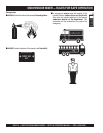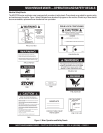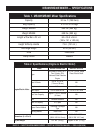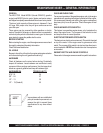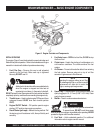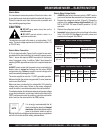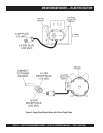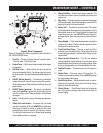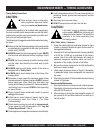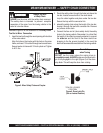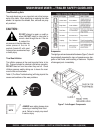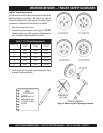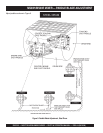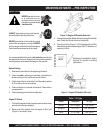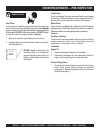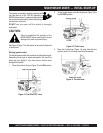
PAGE 18 — MQ STOW MS30H/MS30E MIXER — PARTS & OPERATION MANUAL — REV. #4 (08/10/06)
MS30H/MS30E MIXER — TOWING GUIDELINES
To reduce the possibility of an accident while transporting
the mixer on public roads, always make sure that the trailer
and the towing vehicle are in good operating condition and
both units are mechanically sound.
The following list of suggestions should be used when towing
the mixer:
CAUTION :
Towing Safety Precautions
■
Check with your county or state safety
towing regulations department before
towing your
mortar and plaster mixer
.
■
Make sure that the hitch and coupling of the towing vehicle
are rated equal to, or greater than the trailer "gross vehicle
weight rating" (GVWR).
■
ALWAYS inspect the hitch and coupling for wear. NEVER
tow the mixer with defective hitches, couplings, chains
etc.
■
CHECK the tire air pressure on both the towing vehicle
and the trailer. Also check the tire tread wear on both
vehicles.
■
ALWAYS make sure the trailer section of the mixer is
equipped with a "Safety Chain".
■
ALWAYS attach mixer's safety chain to the frame of the
towing vehicle.
■
Remember in most cases the maximum speed unless
otherwise posted for highway towing is 55 MPH, however
before towing your mixer, check your local state, and
county vehicle towing requirements. Recommended off-
road towing is not to exceed 10 MPH or less depending
on type of terrain.
■
Place
chocked blocks
underneath wheel to prevent
rolling,
while parked.
■
Inflate tires to correct pressure, inspect tires for cuts,
and excessive wear. See Table 4 (Tire Wear
Troubleshooting).
■
Check wheel mounting lug nuts with a torque wrench.
Torque wheel lug nuts as described in the "
Lug Nut
Torque
Requirements
", Table 6.
■
Check tightness of suspension hardware (nuts and bolts).
Mixer Trailer Vehicle Connection
1. Check the vehicle hitch ball, and trailer coupler for signs
of wear or damage. Replace any parts that are worn or
damaged before towing.
2. Use only the 2-inch ball diameter with a towing capability
of 5,000 lbs. (2,268 kg) as indicated on the trailer's
coupler. Use of any other ball diameter will create an
extremely dangerous condition which can result in
separation of the coupler and ball or ball failure.
3. Be sure the coupler is secured to the hitch ball and the
lock lever is down (locked).
4. Attach safety chains as shown in Figure 5. Remember
to
cross
the safety chains underneath the towpole of
the mixer.
5. After towing for about 50 miles recheck the entire towing
system for tightness.
Recommended Maintenance
1. Smear ball socket and clamp face with chassis grease.
Periodically oil pivot points and were surfaces of coupler
with SAE 30 W motor oil.
2. When parking or storing the mixer, keep the coupler off
the ground so dirt and other debris will not build up in
the ball socket.
CAUTION :
If the trailer coupler is deformed replace
entire coupler. NEVER tow the pump with
a defective trailer coupler. There exist the
possibility of the trailer separating from
the towing vehicle.
■
Avoid sudden stops and starts. This can cause skidding, or
jackknifing. Smooth, gradual starts and stops will improve
gas milage.
■
Avoid sharp turns to prevent rolling.
■
DO NOT transport mixer with fuel in the fuel tank.



